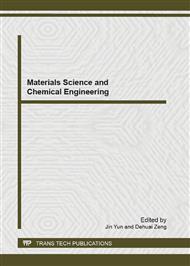p.630
p.637
p.641
p.645
p.650
p.656
p.662
p.667
p.672
Liquid Metallurgy Synthesis and Thermo-Electrical Characterization of Copper-Aluminum Metal Matrix Composite
Abstract:
Samples of copper-aluminum reinforced metal matrix composite (MMC) were prepared by liquid metallurgy method using micron–sized silicon carbide (SiC) particulate. The resultant MMC samples were characterized to determine their thermal, electrical and mechanical properties in respect to varying particle sizes (212, 425, 710 and 1200 mm) of the SiC. The analyses of the results obtained showed that the thermal conductivity of the composite increased with decrease in particle size and volume fraction of the SiC. Also with decrease in grains size, high thermal conductivity was achieved by increasing the volume fraction. The results obtained in this study showed that alloying Cu matrix with aluminium is effective in reducing the interfacial reactions of a typical Cu-SiC matrix composite. The synthesized MMC samples also possessed a combination of high thermal and electrical conductivities with a low coefficient of thermal expansions which is synonymous to a low tensile strain at a maximum load. These properties were achieved for a 60%Cu/Al(40%SiC) at 212 µm, 50%Cu/Al(50%SiC at 12 µm and 70%Cu/Al(30%SiC) at 710 µm. The microstructural evaluation using optical microscopy (OM) indicated good dispersion of the SiC particles in all the samples which consequently enhanced the microhardness obtained in the MMC samples.
Info:
Periodical:
Pages:
650-655
Citation:
Online since:
May 2013
Keywords:
Price:
Сopyright:
© 2013 Trans Tech Publications Ltd. All Rights Reserved
Share:
Citation:


